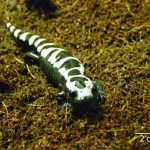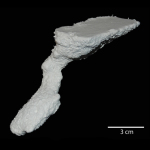Marbled Salamander (Ambystoma opacum)
For full details see Dzenowski and Hembree (2014) in Experimental Approaches to Understanding Fossil Behavior (Topics in Geobiology, Springer)
Description of Organism
- Smallest species in the Ambystoma genus; adults reach lengths of 11 cm
- Range includes the eastern United States, extending from New England to Florida and as far west as Texas
- Inhabits moist soils near streams, ponds, and lakes
- Feeds on small invertebrates
- Lives primarily in burrows, emerging to feed and mate
Published Descriptions of Organism
Dzenowski and Hembree (2014):
- Ambystoma opacum (marbled salamander) has a geographic range extending from New England to Florida and as far west as eastern Texas. This species is the smallest of the ambystomatids, typically reaching adult sizes up to 11 cm in length. the life span of A. opacum is around 4 years, most of which is spend underground in burrows. Individuals mate in the fall, emerging from their burrow after a heavy rain to mate and deposit eggs. Ambystoma opacum burrow passively through compression by the expansion of preexisting cracks, holes or other burrows in the sediment surface.
Burrowing Technique
Ambystoma opacum burrows through compaction only, entering sediment through cracks and holes already present in the surface. The salamanders begin burrowing by forcing their snout into the sediment and then using their hind- and forelimbs to push themselves deeper. Expansion of the burrow is accomplished by moving the head vertically and the body in an undulatory fashion.
Burrowing Technique Video
Burrowing Behavior
Marbled salamanders begin burrowing within 24 hours after being placed in experimental enclosures. Once constructed, burrows tend to remain open to the surface. Burrows are used as temporary shelters to permanent dwelling. Burrows tend to be simple and shallow. Approximately 90% of the salamanders time is spent in the burrow. The salamanders emerged, rarely, during dark hours to feed. When the salamander does emerge from the burrow, it does so through the original opening rather than constructing new openings.
Trace Morphology
Ambystoma opacum produced a single burrow architecture, a subvertical ramp; an example is shown below. The photo is linked to an information page about the specific burrow architecture shown.

